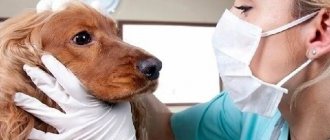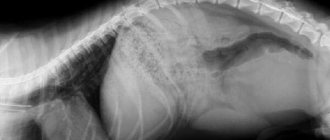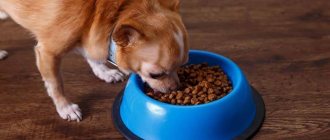Normal breathing in a dog
Respiratory rate is considered an important indicator of a pet's health. If he is healthy, respiration does not require any effort from him. Inhalation is an active process in which the chest expands, the abdominal muscles are activated, and the facial muscles are motionless. Exhalation occurs passively, and the abdominal muscles do not participate in it.
For an adult dog, the norm is 10-30 breaths per minute, but puppies and young dogs breathe more often during their growth period, taking 30-50 breaths. In addition, the respiratory rate depends on the breed, age and physiological state of the pet:
- Small breed dogs breathe more frequently, large breeds take slower and less frequent breaths;
- females have more rapid breathing than males;
- Pregnant and lactating females also take more breaths per minute than other dogs.
The breathing rate can be determined by the movement of the chest and wings of the nose. There is no reason to worry if it does not go beyond the following indicators:
- small dogs (toy terriers, chihuahuas, yorkies) – 15-30 breaths per minute;
- animals of medium breeds - boxers, pugs, etc. – from 10 to 25 inhalations/exhalations;
- large dogs (German shepherds, Labradors, etc.) – 10-20 breaths;
- giant dogs (great Danes, malamutes and others) – 8-20 breathing movements per minute.
In some situations, the breathing rate may change, but rapid breathing does not always indicate that the dog is unhealthy.
Conclusion
As a dog owner, you should always be aware of whether your dog's behavior signals any problems. Even shortness of breath can be a sign that something is bothering your dog, be it excessive heat or illness. However, be careful not to jump to conclusions. In most cases, a dog is breathing with its mouth open - this is simply the dog's body doing what it is designed to do. In most cases, shortness of breath does not mean your furry friend is sick!
Possible causes of rapid breathing
Dogs have a hard time withstanding heat, so in the summer, at high ambient temperatures, in the car during a trip, in a stuffy room, you can observe that the pet is breathing quickly and intensely. In this case, the respiratory rate in a healthy dog can increase to 200 breaths/exhalations per minute, in puppies and young adolescents – up to 60-100.
The dog’s breathing rate also increases during physical activity – when running, during training. Therefore, you can count only 5-10 minutes after class, when the pet has calmed down and the breathing process has returned to normal.
A change in breathing rate can be associated with stress: from loud sounds - gunshots, fireworks, fireworks or under the influence of other negative factors, the dog’s pulse increases and breathing quickens. Even the position of the pet’s body may determine the indicator - in a lying position it is more difficult for a dog to breathe than in a standing position.
A healthy dog breathes through his nose, evenly and almost silently, any wheezing, whistling sounds, etc.
should be considered alarming symptoms that require contacting a veterinarian. The dog breathes through its mouth to replenish oxygen reserves when little of it enters the body during nasal breathing. A dog can die from lack of oxygen. Possible causes of rapid breathing:
- heat stroke, which a pet can get not only on a hot day, walking under the scorching rays of the sun, but also in a stuffy room, in a car;
- chronic and acute diseases of the respiratory system. These include pneumonia, laryngospasm and others. Rapid heavy breathing can also accompany cardiovascular pathologies. Associated symptoms may include cough with sputum, blood and pus, chest pain, loss of coordination and others;
- injuries, the presence of foreign bodies in the respiratory tract, which cause vomiting and increased salivation;
- viral infectious diseases, which are often accompanied by fever, nasal congestion, which makes it difficult for the dog to breathe normally through the nose;
- overstrain of the nervous system - with periodic and regular stress, the causes of which are varied - from loud sounds to visits to the veterinarian or groomer, etc.
In some situations and as an exception, rapid breathing may indicate the activity of the pet’s immune system after vaccination. It may be accompanied by decreased appetite, lethargy, and increased body temperature.
Some of the symptoms of an allergic reaction are watery eyes, nasal discharge, and cough. The dog cannot breathe through its nose, so it breathes more often through its mouth. A dangerous condition is anaphylactic shock. With hypersensitivity to certain medications and other allergens, angioedema may develop, in which the dog's larynx swells.
What to do?
If primary symptoms such as trembling, shortness of breath and palpitations occur, first aid at home must be provided:
- If the animal is lost in space, then most likely it has suffered heatstroke. In this situation, your four-legged friend should be placed in a cool place, given a drink of water and his head covered with a damp cloth.
- In heart failure, the tongue often turns blue and loss of consciousness occurs. With such signs, the paws are warmed with a heating pad and the pet is wrapped in a blanket.
- If there is swelling in the lungs, furosemide helps.
- The dog's panic, followed by loss of consciousness and a bluish color of the tongue, may be signs of a heart attack. Cardamine (five drops) or Corvalol (10-15 drops, depending on the weight of the pet) is dripped onto the tongue.
- When a dog chokes during sleep, wheezing occurs. Medicines intended for the normal functioning of the cardiovascular system are used.
- If breathing is very difficult, give flavored oil or salt a whiff.
- Anxious animals are given medications to reduce stress.
- If your pet exhibits signs such as: avoidance of light, poor coordination of movements and breathing rate with dilation of capillaries, burst and inflamed eyeballs. These are symptoms of severely high blood pressure. Medicines that lower blood pressure: Ramipril, Prazosin. But before giving them, be sure to consult your doctor.
- When a foreign object gets into the mouth. You need to use the Heimlich method. Hug your four-legged pet from behind at the waist. Using the thumb of your hand formed into a fist, press in the area above the navel a couple of times until you inhale forcefully and cough.
In complex therapy, diuretics are used to eliminate the symptoms of the disease, which alleviate the condition of the animal.
Breathing characteristics of some breeds
In representatives of some breeds, rapid breathing can be considered the norm, and not a pathology, and this is due to the anatomical features of the animals. They have an increased pulse, and shortness of breath is associated with the special shape of the skull - a shortened muzzle, narrowed nostrils, and a short soft palate. Such breeds are called brachycephalic. They suffer from infectious and colds more often than other dogs.
Typical representatives of brachycephals are Pekingese and Pugs. It seems that they are constantly wheezing, wheezing, and snoring in their sleep. In fact, it is difficult for them to draw air through their nose. Anatomy also explains the fact that brachycephals quickly overheat, so they often stick out their tongues in an attempt to cool down.
Spitz dogs have a special structure of the larynx, so during illness, as well as in stressful situations, they experience the so-called “reverse sneezing syndrome,” which resembles a cough and increases the respiratory rate.
Features of prevention
Violation of sanitary and hygienic indicators is the reason for the development of a pathological condition. In most cases, lung diseases arise from infectious causes that cause primary pathologies or complicate other diseases. Thus, protecting your dog from infection is the basic principle of preventing respiratory diseases. To do this you need:
- conduct regular examinations of the animal;
- vaccine prevention of common diseases in the region;
- quarterly treatment for worms and fleas (more often in summer).
Another point is maintaining optimal conditions. Inflammatory pathologies of the respiratory organs occur more often in dogs kept in damp, cold, drafty rooms. The autumn period is especially dangerous for guard dogs. They develop a cough - it seems that the animal is choking. It is necessary to make a warm and dry booth for guard dogs, where the bedding is regularly changed.
The spring period leads to an exacerbation of allergic reactions. The dog suffocates when inhaling pollen or poplar fluff. It is impossible to completely remove the animal from allergens, so it is necessary to use antihistamines at an early stage.
If the pet’s breathing quickens, the dog begins to choke, or other signs of pathology of the respiratory system appear and the owner cannot identify the cause and help the animal, then this is a reason to immediately consult a doctor. The sooner help is provided, the greater the chances of saving the dog.
How pregnancy affects
Rapid breathing in pregnant dogs can be observed shortly before birth. Without other signs of pathology, it may indicate a stressful situation, but often also pain. Therefore, you should monitor your pet: if breathing does not normalize, you should contact a veterinarian.
Immediately after birth, a dog may develop eclampsia, which is characterized by shortness of breath, photophobia, and lack of coordination. The condition can be fatal and requires veterinary attention.
Treatment and emergency care - what to do in case of respiratory failure?
Veterinary care for an animal leads to an exacerbation of the stressful condition, which complicates the pathology. Therefore, in some cases (threatening the dog’s life), additional diagnostic procedures should be abandoned until the animal’s condition normalizes. It is better to use narcotic and sedatives to facilitate the examination and treatment of your pet.
Emergency help if your dog is choking:
- examination of the upper respiratory tract and removal of foreign bodies;
- artificial ventilation (oxygen masks, bags);
- tracheotomy (for fractures of the nasal bones, collapse of the larynx;
- intravenous oxygen administration.
After eliminating the threat to the patient’s life, additional diagnostic procedures are performed - radiography, ultrasound. Determining the cause of difficulty breathing will allow you to choose the right treatment aimed at stopping the etiological factor.
If a dog is suffocating due to blockage of the upper respiratory tract, it is necessary to urgently remove bodies and damaged tissues and restore normal respiratory activity. Otherwise, intubation is performed. Intravenous administration of dexamethasone at a dose of 0.5 mg/kg or similar corticosteroids has a good positive effect. Be sure to monitor the dog's temperature - hyperthermia leads to increased breathing, so antipyretic drugs and cold compresses are used.
Treatment of pulmonary edema is aimed at restoring cardiovascular activity and removing excess fluid. Dogs are prescribed furosemide or other diuretics. Means for dilating blood vessels allow you to normalize the functioning of the heart - use nitroglycerin. Be sure to support the work of the heart muscle with dobutamine or analogues.
In case of bronchopneumonia, it is necessary to eliminate the exudate accumulating in the bronchi and alveoli. To do this, a general course of antibiotics is administered to suppress pathogenic microflora. Improve ventilation of the lungs with the help of bronchodilators. Mucaltin and bromhexine are used as expectorants. General compensatory therapy is carried out - intravenous injections of plasma substitutes, saline solution, glucose.
Diagnostics
The first thing you need to check is whether there are objective reasons that provoke rapid breathing (heat, stress, significant physical activity) and, if there are, eliminate them. If tachypnea persists after external causes have been ruled out, does not improve over time, or worsens, you should contact your veterinarian and have your pet examined.
- A general clinical blood test, biochemical analysis of blood and urine are performed first. Abnormalities may indicate causes of tachypnea such as anemia, infection and diabetes.
- Test for helminthic infestation
- Study of the gas composition of arterial blood.
- It is important to perform a chest x-ray. This will help rule out a foreign body in the upper respiratory tract or a tumor.
- Ultrasound of the heart and chest cavity.
- Thoracentesis (pleurocentesis) - puncture of the chest wall with collection of fluid or pus accumulated in the pleural cavity and its subsequent analysis
- More complex diagnostic methods involve the use of rhinoscopy or tracheobroncoscopy (an endoscopic method for examining the lumen and mucous membrane of the bronchi and trachea) and CT.
The dog is breathing heavily and frequently, what should I do?
Quite often, the cause of heavy breathing in a dog is heart problems. They usually appear in dogs over 8 years of age. Indeed, mature dogs can suffer from cardiovascular diseases.
The dog is breathing heavily and frequently, what to do:
- While walking, running, or active games, the dog gets tired very quickly and sticks out its tongue. Take a closer look at the color of the tongue. If it is blue, the dog most likely has heart problems. However, it is also necessary to pay attention to how the pet behaves.
- The accompanying symptoms can tell a lot. If this is an infectious disease, the dog may tremble, its performance decreases, and any desire to have fun, walk or run disappears.
- If previously your pet happily enjoyed a walk in the park and chased abandoned sticks, now he is very lethargic, trying to go into the shade and lie down. In this case, you need to pay attention to his breathing and body temperature.
- If you fed your dog unusual food, perhaps he picked up something on the street, after which rapid breathing, vomiting and diarrhea appeared, this indicates poisoning. It is necessary to rinse the dog’s stomach and give several tablets of activated carbon.
- The injury is difficult to miss; most often it manifests itself as damage to the skin, or uncharacteristic changes in the contours of the body. What usually happens with closed rib fractures.
On a walk
Why does a dog breathe frequently after giving birth?
Particular attention should be paid to a dog who has recently become a mother. The fact is that the birth of puppies is a serious stress for the body, which can cause the development of certain ailments.
Why does a dog breathe frequently after giving birth:
- It is generally accepted that increased breathing during childbirth and 15 minutes after it is physiological, since it is during this period that the body needs a lot of oxygen. In the first 15 minutes after the birth of the first baby, it is necessary for the dog to produce a large amount of milk.
- It is at this moment that a lot of milk arrives in the mammary glands, and the amount of oxytocin and other sex hormones increases in the blood. All this is necessary for the birth to end safely, and for the girl to be able to give birth not only to puppies, but also to a placenta.
- If rapid breathing occurs for longer than 15 minutes, try palpating your pet's abdomen. Perhaps the rapid breathing is due to the fact that not all puppies were born. This happens if the first babies are stillborn. Perhaps labor has stopped and one or two puppies remain in the belly. You can easily determine this by palpating the lower abdomen.
Cute dog
Why does swelling of the tongue still occur?
We list the most common reasons why an organ may swell:
- an allergic reaction resulting in Quincke's edema;
- glossitis disease or an inflammatory process that affects the tissues of the tongue;
- hypothyroidism or diseases of the endocrine system;
- infectious diseases, when the tongue may suddenly swell;
- injury caused by a broken piece of tooth, or incorrect prosthetics;
- disruption of the metabolic process;
- malignant formations;
- complications caused by piercing, etc.
An experienced doctor will help determine the true cause of swelling of the tongue, who will diagnose the oral cavity under the careful supervision of the patient.
The dog breathes rapidly, sticks out its tongue and trembles
Owners of small dogs, such as the Yorkshire Terrier, often experience rapid breathing. Most often, such dogs are kept as a home pillow or toy.
The dog breathes frequently with its tongue hanging out and trembles:
- Therefore, they receive very little attention. The main task of the owners in this case is to feed and groom the dog. However, it is worth remembering that this dog also needs frequent walks and muscle training.
- Therefore, it is necessary to walk them as often as large breeds of dogs. That is three times a day. It is advisable to do this not for 10 minutes, but much longer, so that the dog can run properly and tense his muscles.
- It is precisely because many owners keep such dogs in greenhouse conditions that they often go to the toilet in the diaper, and not outside, the dogs become overgrown with fat and become obese. Problems with the cardiovascular system appear. This is why rapid breathing may occur.
Almost all dogs in the summer, due to the presence of a thick fur coat, can breathe very quickly, sticking out their tongue. This is not a pathology, try to save your pet from the heat.
First aid
- Calm down. If you see that your pet is out of breath after running or is scared of something, try to calm him down. Stroke him, talk to him kindly, sit on a bench. After the animal has calmed down, you can continue your walk.
- Reduce body temperature . Move your dog to a cool place with circulated air. Do not pour water on your dog, as a sudden change in temperature causes blood vessels to constrict. It is enough to moisten the stomach and armpits generously, and put a damp towel on your head, changing it periodically.
- Provide blood flow to the brain . To do this, place the dog so that the head is below body level.
- Give yourself an enema . A great way to lower your body temperature is with a cool water enema. After the procedure, body temperature 39-40°C is quite normal.
Why does my dog pant and whine frequently?
Frequent breathing, which is characterized by wheezing, whistling, and shallow breathing, indicates that the dog is sick with a viral or bacterial disease. She has pneumonia or bronchitis. Usually a whistling, short sound is heard when exhaling. Very often, before these symptoms, the dog experiences nasal discharge. Most likely, pneumonia is provoked by an exacerbation and deterioration in health after a viral infection.
Why does a dog pant and whine frequently?
- Frequent breathing can be caused by parasites. Oddly enough, infection with worms affects not only the state of the dog’s digestive system, but also the functioning of a large number of organs.
- The fact is that some types of worms live not only in the gastrointestinal tract. Some of them live in the dog's lungs. Therefore, parasites can provoke coughing, sneezing, and rapid breathing.
- Wheezing may be heard and symptoms similar to bronchitis may be observed. However, most often, infection with worms is not accompanied by a high temperature. Usually all vital signs are normal, but the dog becomes lethargic and may wheeze.
- In this case, you need to consult a doctor and be examined for worms. Much attention should be paid to this if you switched from artificial food to natural food and gave your dog raw meat.
At the doctor's appointment
My dog is breathing frequently after giving birth, what should I do?
But there are also pathological causes of rapid breathing after childbirth, especially they are observed the next day or a few days later. The fact is that almost all the body’s energy reserves during this period are spent on babies, that is, milk.
The dog is breathing frequently after giving birth, what to do:
- In order to produce it in sufficient quantities, the mother’s body is literally emptied; there is no calcium or glucose left in it. That is why a decent proportion of females after childbirth are faced with a disease such as eclampsia.
- Take a close look at your pet; if, along with rapid breathing, the paws stretch out, become as if wooden, or the female cannot rise on her hind legs, limps, drags them along with her, this is a reason to urgently go to the doctor.
- It is best if you purchase a solution of glucose and calcium gluconate in advance to give the necessary injection. There are drugs that are administered intramuscularly, usually injected into the dog's thigh. The amount of product is selected depending on the weight of the pet.
A pet











